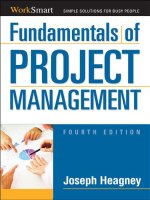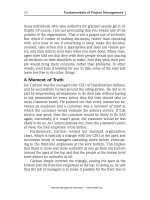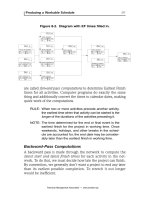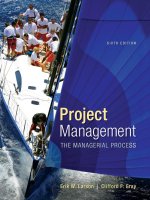Exploring management 6th by schermerhornch15
Bạn đang xem bản rút gọn của tài liệu. Xem và tải ngay bản đầy đủ của tài liệu tại đây (274.1 KB, 34 trang )
Exploring Management
John R. Schermerhorn Jr. and Daniel G. Bachrach
Sixth Edition
Chapter 15
Communication
Kayak.com’s chief technology officer Paul English
bought a two-foot-tall elephant toy, Annabelle, for
the conference room.
This elephant can’t be ignored. “So often at work,”
he says, “people have issues that they can’t resolve
because they won’t talk about it.”
Copyright © 2018 John Wiley & Sons, Inc.
2
Your Chapter 15 Takeaways
• Understand the nature of communication and when it is effective. (15.1)
• Identify the major barriers to effective communication. (15.2)
• Discuss ways to improve communication with people at work. (15.3)
Copyright © 2018 John Wiley & Sons, Inc.
3
EFFECTIVE COMMUNICATION 15.1
Takeaway 15.1 – answers to come
• Communication helps to build social capital.
• Communication is a process of sending and receiving messages with meanings
attached.
• Communication is effective when the receiver understands the sender’s messages.
• Communication is efficient when it is delivered at low cost to the sender.
• Communication is persuasive when the receiver acts as the sender intends.
Copyright © 2018 John Wiley & Sons, Inc.
4
EFFECTIVE COMMUNICATION 15.1
Communication
Social capital
• The capacity to attract support and help from others in order to get things done
• Managers need social capital and must be skilled communicators to get and keep it.
• The best managers and team leaders thrive as communication nerve centers whose
social capital grows while they gather information, process it, use it for problem solving,
and share it with others.
Copyright © 2018 John Wiley & Sons, Inc.
5
EFFECTIVE COMMUNICATION 15.1
Communication Process
Communication
•
Process of sending and receiving messages with meanings attached
Communication Skills Self-Check
Convey positive image in communications.
Use e-mail and social media well.
Write clearly and concisely
Network with peers and mentors.
Run and contribute to meetings.
Give persuasive presentations.
Give and receive constructive feedback
Copyright © 2018 John Wiley & Sons, Inc.
6
EFFECTIVE COMMUNICATION 15.1
Major Elements of Interpersonal Communication
Figure 15.1 What Are the Major Elements of Interpersonal Communication?
Copyright © 2018 John Wiley & Sons, Inc.
7
EFFECTIVE COMMUNICATION 15.1
Communication Process
• Effective Communication
• Receiver must understand the sender’s message
• Efficient Communication
• Communication occurs at minimum cost in terms of resources.
• These costs, time and convenience, in particular, often become very influential in
how we choose to communicate.
Copyright © 2018 John Wiley & Sons, Inc.
8
EFFECTIVE COMMUNICATION 15.1
Communication Process
• Persuasive communication
• Convincing others to accept, support, and act consistent with the sender’s message.
• Credible communication
• Earns trust, respect, and integrity in the eyes of others
• Charisma
• ability to inspirationally persuade and motivate
• Charismatic leadership tactics
• Communication techniques people use to make themselves more “leader-like” and be
perceived by others as influential and trustworthy.
Copyright © 2018 John Wiley & Sons, Inc.
9
EFFECTIVE COMMUNICATION 15.1
Study Guide for Takeaway 15.1
Rapid Review:
•
Communication is the interpersonal process of sending and receiving symbols with messages
attached to them.
•
Effective communication occurs when the sender and the receiver of a message both interpret it in
the same way.
•
•
•
Efficient communication occurs when the sender conveys the message at low cost.
Persuasive communication results in the recipient acting as the sender intends.
Credibility earned by expertise and good relationships is essential to persuasive communication.
Copyright © 2018 John Wiley & Sons, Inc.
10
EFFECTIVE COMMUNICATION 15.1
Study Guide for Takeaway 15.1
Questions for Discussion:
1.
Why do recruiters place so much emphasis on the communications skills of job
candidates?
2.
Can you describe a work situation where it’s okay to accept less communication
effectiveness in order to gain communication efficiency?
3.
What can a manager do to gain the credibility needed for truly persuasive
communication?
Copyright © 2018 John Wiley & Sons, Inc.
11
EFFECTIVE COMMUNICATION 15.1
Be Sure You Can…for Takeaway 15.1
• describe the communication process and identify its key components
• define and give an example of effective communication
• define and give an example of efficient communication
• explain why an effective communication is not always efficient
• explain the role of credibility in persuasive communication
Copyright © 2018 John Wiley & Sons, Inc.
12
COMMUNICATION BARRIERS 15.2
Takeaway 15.2 – answers to come
• Poor use of channels makes it hard to communicate effectively.
• Poor written or oral expression makes it hard to communicate effectively.
• Failure to spot nonverbal signals makes it hard to communicate effectively.
• Information filtering makes it hard to communicate effectively.
• Overloads and distractions make it hard to communicate effectively.
Copyright © 2018 John Wiley & Sons, Inc.
13
COMMUNICATION BARRIERS 15.2
Communication Channels
• Poor use of channels makes effective communication difficult
• Noise interferes with the communication process
Figure 15.2 How Does Noise Interfere with the Communication Process?
Copyright © 2018 John Wiley & Sons, Inc.
14
COMMUNICATION BARRIERS 15.2
Communication Channels
• Communication channels
•
Medium used to carry message
• Channel richness
•
Ability of the channel to convey meaning
Copyright © 2018 John Wiley & Sons, Inc.
15
COMMUNICATION BARRIERS 15.2
Effective Communication
• Poor written or oral expression makes it hard to communicate effectively
• Communication will only be effective when the sender expresses the message in a
way that is clearly understood by the receiver.
• Words must be well chosen and used properly, something we all too often fail to do.
Copyright © 2018 John Wiley & Sons, Inc.
16
COMMUNICATION BARRIERS 15.2
Effective Communication Tips
Essential Ingredients of Successful Presentations
Be prepared—Know what you want to say, how you want to say it, and rehearse saying it.
Do the housekeeping—Attend to details, and have room, materials, and arrangements ready
Check technology—Go over everything ahead of time, making sure it works
Be professional—Be on time; dress appropriately; act organized, confident, and enthusiastic.
Set the right tone—Focus on your audience, make eye contact, “speak” don’t “read,” and act pleasant and confident.
Sequence your points—State your purpose, make important points, follow with details, summarize.
Support your points—Give specific reasons for your points; state in understandable terms.
Accent the presentation—Use good visual aids, and provide handouts to add details and a summary overview.
Finish strong—Pull everything together in a concise, clear, and enthusiastic conclusion, and invite and welcome questions.
Copyright © 2018 John Wiley & Sons, Inc.
17
COMMUNICATION BARRIERS 15.2
Communication Channels
• Nonverbal communication
• Gestures, expressions, posture and interpersonal space
• The ways we use nonverbal communication can also work for or against our
communication effectiveness
• Mixed messages
• Words and nonverbal signals don’t match
Copyright © 2018 John Wiley & Sons, Inc.
18
COMMUNICATION BARRIERS 15.2
Communication Channels
• Information filtering
• Intentional distortion of information to make it more favorable
to the recipient
• Physical distractions
• Plan message to minimize distractions and interruptions
Copyright © 2018 John Wiley & Sons, Inc.
19
COMMUNICATION BARRIERS 15.2
Study Guide for Takeaway 15.2
Rapid Review:
• Noise interferes with the effectiveness of communication.
• Poor choice of channels can reduce communication effectiveness.
• Poor written or oral expression can reduce communication effectiveness.
• Failure to accurately read nonverbal signals can reduce communication effectiveness.
• Filtering caused by status differences can reduce communication effectiveness.
Copyright © 2018 John Wiley & Sons, Inc.
20
COMMUNICATION BARRIERS 15.2
Study Guide for Takeaway 15.2
Questions for Discussion:
1.
2.
3.
When is texting not an appropriate way to convey a message in a work
situation?
If someone just isn’t a good writer or speaker, what can he or she do to
improve communication skills?
How can a higher-level manager avoid the problem of filtering when lowerlevel staffers pass information upward to her?
Copyright © 2018 John Wiley & Sons, Inc.
21
COMMUNICATION BARRIERS 15.2
Be Sure You Can…for Takeaway 15.2
• list common sources of noise that can interfere with effective communication.
• discuss how the choice of channels influences communication effectiveness.
• give examples of poor language choices in written and oral expression.
• clarify the notion of mixed messages and how nonverbals affect communication.
• explain how filtering operates in upward communication.
Copyright © 2018 John Wiley & Sons, Inc.
22
COMMUNICATION BARRIERS 15.3
Takeaway 15.3 – answers to come
• Active listening helps people say what they really mean.
• Constructive feedback is specific, timely, and relevant.
• Office spaces can encourage interaction and communication.
• Transparency and openness ensure that accurate information is shared.
• Appropriate online behavior can facilitate better communication.
• Sensitivity and etiquette can improve cross-cultural communication.
Copyright © 2018 John Wiley & Sons, Inc.
23
IMPROVING COMMUNICATION 15.3
Improving Communication
• Active listening helps people to say what they really mean.
• Constructive feedback is specific, timely, and relevant.
• Office spaces can be designed to encourage interaction and communication.
• Transparency and openness ensure that accurate information is shared.
• Appropriate use of technology can facilitate more and better communication.
• Sensitivity and etiquette can improve cross-cultural communication.
Copyright © 2018 John Wiley & Sons, Inc.
24
IMPROVING COMMUNICATION 15.3
Active Listening
• Active listening
• Helps the source of a message say what he or she really means
Active Listening Skills
Listen for message content:
Try to hear exactly what content is being conveyed in the message.
Listen for feelings:
Try to identify how the source feels about the content in the message.
Respond to feelings:
Let the source know that her or his feelings are being recognized.
Note all cues:
Be sensitive to nonverbal and verbal messages; be alert for mixed messages.
Paraphrase and restate:
State back to the source what you think you are hearing.
Copyright © 2018 John Wiley & Sons, Inc.
25









